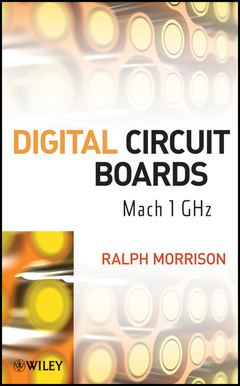Description
Digital Circuit Boards
Mach 1 GHz
Author: Morrison Ralph
Language: English
Subject for Digital Circuit Boards:
Keywords
demand; practical; design; circuit; approach; designs; everfaster; digital; theory; boards; alternative; emphasizing; logic; energy flow; interconnection; explain; behavior; signal; transmission; lines; terms; book
184 p. · 16x24.4 cm · Hardback
Description
/li>Contents
/li>Biography
/li>
A unique, practical approach to the design of high-speed digital circuit boards
The demand for ever-faster digital circuit designs is beginning to render the circuit theory used by engineers ineffective. Digital Circuit Boards presents an alternative to the circuit theory approach, emphasizing energy flow rather than just signal interconnection to explain logic circuit behavior.
The book shows how treating design in terms of transmission lines will ensure that the logic will function, addressing both storage and movement of electrical energy on these lines. It covers transmission lines in all forms to illustrate how trace geometry defines where the signals can travel, then goes on to examine transmission lines as energy sources, the true nature of decoupling, types of resonances, ground bounce, cross talk, and more.
Providing designers with the tools they need to lay out digital circuit boards for fast logic and to get designs working the first time around, Digital Circuit Boards:
Reviews in simple terms the basic physics necessary to understand fast logic design
Debunks the idea that electrical conductors carry power and signals, showing that signal travels in the spaces, not the traces, of circuit boards
Explains logic circuit behavior through real-time analysis involving the fields and waves that carry signal and energy
Provides new information on how ground/power planes work
Outlines a software program for solving energy flow in complex networks
Preface xi
1 BASICS 1
1.1 Introduction 1
1.2 Why the Field Approach is Important 3
1.3 The Role of Circuit Analysis 4
1.4 Getting Started 5
1.5 Voltage and the Electric Field 6
1.6 Current 7
1.7 Capacitance 8
1.8 Mutual and Self-Capacitance 10
1.9 E Fields Inside Conductors 11
1.10 The D Field 12
1.11 Energy Storage in a Capacitor 12
1.12 The Energy Stored in an Electric Field 13
1.13 The Magnetic Field 13
1.14 Rise Time/Fall Time 15
1.15 Moving Energy into Components 15
1.16 Faraday's Law 16
1.17 Self- and Mutual Inductance 16
1.18 Poynting’s Vector 17
1.19 Fields at DC 18
2 TRANSMISSION LINES 22
2.1 Introduction 22
2.2 Some Common Assumptions 24
2.3 Transmission Line Types 25
2.4 Characteristic Impedance 27
2.5 Wave Velocity 29
2.6 Step Waves on a Properly Terminated Line 30
2.7 The Open Circuited Transmission Line 31
2.8 The Short Circuited Transmission Line 33
2.9 Waves that Transition between Lines with Different Characteristic Impedances 35
2.10 Nonlinear Terminations 38
2.11 Discharging a Charged Open Transmission Line 38
2.12 Ground/Power Planes 40
2.13 The Ground and Power Planes as a Tapered Transmission Line 41
2.14 Pulling Energy from a Tapered Transmission Line (TTL) 43
2.15 The Energy Flow Through Cascaded (Series) Transmission Lines 45
2.16 An Analysis of Cascaded Transmission Lines 48
2.17 Series (Source) Terminating a Transmission Line 49
2.18 Parallel (Shunt) Terminations 50
2.19 Stubs 52
2.20 Decoupling Capacitor as a Stub 54
2.21 Transmission Line Networks 54
2.22 The Network Program 55
2.23 Measuring Characteristic Impedance 56
3 RADIATION AND INTERFERENCE COUPLING 61
3.1 Introduction 61
3.2 The Nature of Fields in Logic Structures 62
3.3 Classical Radiation 62
3.4 Radiation from Step Function Waves 63
3.5 Common Mode and Normal Mode 66
3.6 The Radiation Pattern along a Transmission Line 70
3.7 Notes on Radiation 70
3.8 The Cross Coupling Process (Cross Talk) 71
3.9 Magnetic Component of Cross Coupling 72
3.10 Capacitive Component of Cross Coupling 74
3.11 Cross Coupling Continued 75
3.12 Cross Coupling between Parallel Transmission Lines of Equal Length 76
3.13 Radiation from Board Edges 78
3.14 Ground Bounce 79
3.15 Susceptibility 80
4 ENERGY MANAGEMENT 82
4.1 Introduction 82
4.2 The Power Time Constant 84
4.3 Capacitors 86
4.4 The Four-Terminal Capacitor or DTL 87
4.5 Types of DTLs 89
4.6 Circuit Board Resonances 90
4.7 Decoupling Capacitors 90
4.8 The Board Decoupling Problem 92
4.9 The IC Decoupling Problem 93
4.10 Comments on Energy Management 94
4.11 Skin Effect 95
4.12 Dielectric Losses 97
4.13 Split Ground/Power Planes 97
4.14 The Analog/digital Interface Problem 98
4.15 Power Dissipation 99
4.16 Traces through Conducting Planes 100
4.17 Trace Geometries that Reduce Termination Resistor Counts 101
4.18 The Control of Connecting Spaces 101
4.19 Another way to look at Energy Flow in Transmission Lines 103
5 SIGNAL INTEGRITY ENGINEERING 106
5.1 Introduction 106
5.2 The Envelope of Permitted Logic Levels 107
5.3 Net Lists 108
5.4 Noise Budgets 108
5.5 Logic Level Variation 109
5.6 Logic and Voltage Drops 110
5.7 Measuring the Performance of a Net 111
5.8 The Decoupling Capacitor 112
5.9 Cross Coupling Problems 114
5.10 Characteristic Impedance and the Error Budget 114
5.11 Resistor Networks 116
5.12 Ferrite Beads 117
5.13 Grounding in Facilities: A Brief Review 118
5.14 Grounding as Applied to Electronic Hardware 120
5.15 Internal Grounding of a Digital Circuit Board 123
5.16 Power Line Interference 124
5.17 Electrostatic Discharge 125
6 CIRCUIT BOARDS 130
6.1 Introduction 130
6.2 More about Characteristic Impedance 131
6.3 Microstrip 133
6.4 Centered Stripline 135
6.5 Embedded Microstrip 136
6.6 Asymmetric Stripline 137
6.7 Two-Layer Boards 140
6.8 Four-Layer Circuit Board 143
6.9 Six-Layer Boards 145
Glossary 147
Abbreviations and Acronyms 149
Bibliography 157
Index 159
Ralph Morrison is a consultant and lecturer in the area of interference control and electronics. He has thirty years of design and consulting experience, was president of Instrum for more than a decade, and has authored Noise and Other Interfering Signals, Grounding and Shielding in Facilities, and Solving Interference Problems in Electronics, all from Wiley.
These books may interest you

Fast Circuit BoardsEnergy Management 121.75 €



